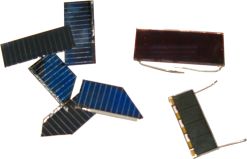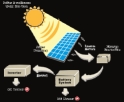There are many places online that offer information about do it yourself solar panels (Photo Voltaic). Some of them are great resources and some are downright scams. In this post I discuss why making your own panels can be a bad idea and links where to find FREE how to guides should you want to build them anyway.
5 Reasons why NOT to make your own solar panels.
- Cost effectiveness: Over the past several years the cost of solar panels has decreased dramatically. You can purchase really inexpensive price per watt panels (mostly made in China) at places like Harbor Freight or Costco. The time in sourcing the materials and manual labor in assembly no longer offers a tremendous cost savings over store bought units.
- What You’re Getting: When you build your own, they are typically put together from individual “scratch and chip” cells, purchased in bulk, from manufacturer rejects. Although the lack of uniformity usually doesn’t effect output much, you’re starting with components already deemed inadequate by retail standards. Also, the quality of the pieces will differ from one retailer to the next so essentially it’s a pig in a poke opening the box.
- Lifespan: Homemade panels typically do not last as long and have a decrease in power output more quickly than manufactured ones. There is also no warranty, or recourse, should they stop functioning properly.
- No Qualification / Law: DIY solar panels are not eligible for any type of tax credits or incentives due to their lack of certification. They would likely not be compliant with electrical mandates, building codes or insurance specifications.
- Potential Hazards: Besides the potential blisters from soldering the cells, working with electricity can also be dangerous. Another issue can be fire hazards. Building your own solar panels consists of using materials like, cardboard, wood, plastics, glues, etc. Setting a unit up in the sun and having electricity run through it can potentially create a fire if done incorrectly.
Why would you make your own solar panels?
- Satisfaction: There is a great deal of gratification in building things yourself. The satisfaction of being more self reliant is also a big draw.
- Learning: Putting together your own panels is a constructive way to learn or teach someone about solar power and it’s potential.
- Small Projects: If you aren’t looking to power your whole home, a DIY solar kit or individually sourced pieces, can be a fun, affordable and sensible way to complete a small endeavor like lighting a shed.
Before I get to far into resources, let me preface by saying…if you have spent anytime at all looking online, then you will have undoubtedly come across websites whose only aim is to sell guides on DIY solar panels. The cost of these programs / instructional documents will vary but, they’re almost always a complete ripoff. The information they contain is readily available online, for free, or is completely inaccurate / misleading. I would not personally recommend spending a nickle for info on how to assemble your own panels. Below are some places to get started.
Here is a good video for how it’s generally done (part 1 of 2)…
A couple websites with step by step instructions, parts lists and photos…
Instructables: Home Solar Panel Guides (many projects)
Mikes’ Build Experience (parts list, pics & good info)
Have another quality resource? Share it!








